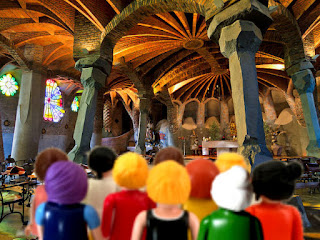 |
| The Watsons visit La Casa del Mestre, Colònia Güell |
Today, The Watsons and The Grandma have visited the neighboured Colònia Güell in Santa Coloma de Cervelló.
They have spent the day visiting this incredible site and learning more things about Antoni Gaudí and his influence in this textile colony, and near it, in Sant Boi Mental Hospital, where all indicates, he started his works.
The Watsons have continued their English for Sales courses surrounded by nature in this amazing and unforgettable place, a must for Antoni Gaudí's admirers but also for everyone who likes Architecture and History. They have revised the irregular forms of the Past Simple.
More information: Past Simple-Irregular Forms
The Colònia Güell, one of the most pioneering purpose-built industrial villages of the 19th century is located in the town of Santa Coloma de Cervelló, 23 Km to the south-west of Barcelona.
Gaudí developed the architectural innovations of his later works in the church crypt, which has been designated a Unesco World Heritage Site.
The Church of Colònia Güell, in Catalan Cripta de la Colònia Güell, is an unfinished work by Antoni Gaudí. It was built as a place of worship for the people on a hillside in a manufacturing suburb in Santa Coloma de Cervelló, near Barcelona, Catalonia.
More information: Portal Gaudí
Colònia Güell was the brainchild of Count Eusebi Güell; who enlisted the help of architect Antoni Gaudí in 1898. However, work was not started until 1908, 10 years after commission. The plan for the building consisted of constructing two naves, an upper and a lower, two towers, and one forty-meter-high central dome.
In 1914, the Güell
family halted construction due to the death of Count Güell. At the time,
the lower nave was almost complete so between the years of 1915 and
1917, it was completed and readied for use.
 |
| The Watsons visit La Cripta, Colònia Güell |
The Church is one of the seven properties Gaudí built near Barcelona that are Unesco World Heritage Sites. Collectively, these sites are known as the Works of Antoni Gaudí, and show his, exceptional creative contribution to the development of architecture and building technology in the late 19th and early 20th centuries.
At the age of 28, the Church of Colònia Güell was one of several commissions Gaudí received from Count Güell in the suburb of Santa Coloma de Cervelló.
To start the designing process of the church, Gaudí used his very unique process of gravity and rope, known as a funicular system. As seen in the planning of La Sagrada Família, Gaudí hung hemp ropes attached to lead-filled sacks from the ceiling. By doing this, it allowed him to reproduce the curves of the church at a 1:10 scale.
Gaudí also used canvas sheets to imitate the vaults and walls of the structure. By weighing down the ropes with lead-filled sacks, it allowed him to see the loads that would be exerted on the actual structure. To turn this hanging structure into his actual design, Gaudí photographed his model, flipped the image, and traced over it while adding some ornament and design. All that remains of the model for Church of Colònia Güell is an image in a book written by architect Josep Francesc Ráfols i Fontanals.
More information: Catalunya
This method of planning led to the development of a new architectural vocabulary, such as hyberbolic paraboloids and hyperboloids, which are prominent elements in many of Gaudí's designs.
The crypt portion of the church, constructed from 1908 to 1915, was the only segment of the church that was fully completed. It was built partially below ground, due to being on a hillside, and it was designed so that it would feel like it belonged in the surrounding nature. There are pillars on the exterior of the crypt, made of many bricks, while others were made of a solid block of stone. The roof of the structure has a geometric shape that is morphed by the connecting of the various pillars.
The crypt is very dimly lit, due to it being built partially underground since the structure is on a hillside. There are however, 22 lead stained glass windows in the crypt, to let in some colorful lighting.
Although it remains unfinished, the chapel is a very important aspect of the church. The designs of the chapel is similar to that of the Sagrada Família. This is a common theme seen throughout the church, since Gaudí used it in preparation for the building of the Sagrada Família. He tested many of his ideas and theories here, since Güell gave him the liberty of being as creative as possible.
The shape of the worship area was planned in extensive detail, right down to the pews. All of the furniture in the Church was designed by Gaudí himself, and have been preserved. Very few pieces of his furniture have been saved, though some examples are still seen in the Sagrada Família and private homes.
More information: The Culture Trip
Color in certain places has the great value of making
the outlines and structural planes seem more energetic.
Antoni Gaudí
No comments:
Post a Comment